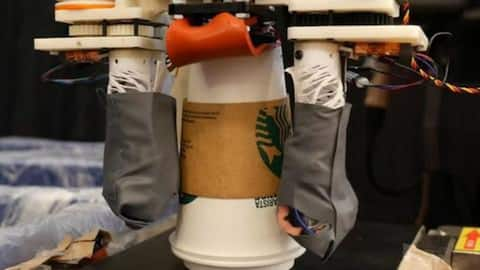MIT's new robot has a sense of touch, detects objects
What's the story
Sorting waste material before recycling is a hazardous labor-intensive job. But, if we employ machines for the task, the entire problem could be solved in a smarter, safer way. That is exactly what MIT's CSAIL team is trying to do with RoCycle, a robot that comes with a sense of 'touch' and could one day handle waste-sorting all alone. Here's how it works.
Working
RoCycle and its touch-based system
RoCycle comes with a pair of sensor-equipped hands that can hold an object and determine its nature according to its rigidity. A strain sensor is used to determine the size of the object, be it a can or cardboard box, while a couple of pressure sensors are used to assess how squishy it is. Once nature is determined, the bot sorts the product accordingly.
Hands
RoCycle has flexible hands
As MIT shows in a video, RoCycle's fingers are made from a special material called auxetics. It widens and twists on being stretched, allowing higher flexibility and dexterity than what we see with regular robotic hands, Engadget reported. Also, as the hand sensors are conductive, they can easily detect metal objects and distinguish them with those that just look like metal.
Performance
Plus, performance is really promising
Despite lacking computer vision, RoCycle has shown promising results in lab tests. The machine detected and sorted stationary objects with an impressive 85% accuracy, while object moving on the conveyor belt were detected with 63% accuracy. MIT's video showed how seamlessly the machine detected, held, and dropped the objects in the bags they belonged to.
Development
More developments could bring this machine into recycling business
Now, with a few more developments and perhaps integration of a computer vision system, the accuracy of RoCycle could be improved, making it capable enough for handling sorting in a real recycling facility. However, that might take a bit of time because working in a lab environment and a real facility are two different things, with a lot of complexities involved in the latter.
